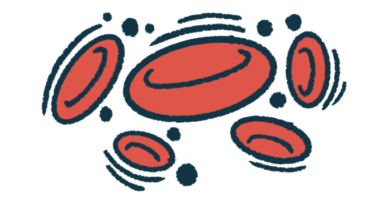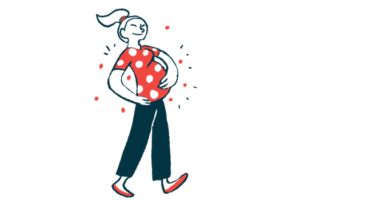PiaSky (crovalimab-akkz) for paroxysmal nocturnal hemoglobinuria
Last updated Sept. 10, 2024, by Marisa Wexler, MS

What is PiaSky for PNH?
PiaSky (crovalimab-akkz) is an antibody-based therapy that is approved for paroxysmal nocturnal hemoglobinuria (PNH).
The therapy was originally created by Chugai Pharmaceutical and it is being marketed in the U.S. by Genentech, both Roche subsidiaries. It seeks to reduce the destruction of red blood cells in people with PNH.
PiaSky is administered via a subcutaneous (under-the-skin) injection, following an initial loading dose that’s given by intravenous (into-the-vein) infusion.
Therapy snapshot
| Brand name: | PiaSky |
| Chemical name: | Crovalimab-akkz |
| Usage: | Reduce red blood cell destruction |
| Administration: | Subcutaneous injection following initial intravenous infusion |
How does PiaSky work?
In PNH, blood cells lack certain proteins on their surface. As a result, a part of the immune system called the complement system becomes abnormally activated and destroys blood cells, driving disease symptoms.
PiaSky is a novel recycling monoclonal antibody that is designed to stop red blood cell destruction — a process called hemolysis — by blocking the activation of the complement system. The therapy specifically does so by targeting a complement protein called C5, and preventing it from being cleaved, or split, into two subunits (C5a and C5b). Through this mechanism, PiaSky is expected to inhibit intravascular hemolysis — red blood cell destruction occurring inside blood vessels — mediated by complement activation.
Two other approved PNH therapies, Soliris (eculizumab) and Ultomiris (ravulizumab), also work by targeting C5.
PiaSky aims to provide a more convenient dosing regimen than either Soliris, which is given by an infusion into the bloodstream every other week, or Ultomiris, which is given by infusion every other month or by subcutaneous injection once weekly (in adults only). Because PiaSky uses Chugai’s recycling antibody technology, the therapy can bind to C5 multiple times, which in turn enables it to be given less frequently and at lower doses via subcutaneous injections.
Who can take PiaSky?
The U.S. Food and Drug Administration (FDA) approved PiaSky for the treatment of PNH in June 2024. The therapy is indicated to treat adults and children, ages 13 and older, who weigh at least 40 kilograms, or 88 pounds.
Due to the risk for serious infections, PiaSky is only available in the U.S. through a restricted access program, called PIASKY REMS. REMS stands for Risk Evaluation and Mitigation Strategy. Healthcare providers prescribing PiaSky must enroll in the program and be certified. Prescribers must also inform patients of the potential risks of treatment and assess their vaccination status for meningococcal vaccines, ensuring they meet current recommendations before receiving treatment. The program also ensures that the medication can only be dispensed at certified pharmacies.
PiaSky was also approved for the treatment of PNH in China in February 2024 and in Japan in March 2024. The therapy has also been approved in Europe for the treatment of PNH patients ages 12 and older and weighing at least 40 kg.
Who should not take PiaSky?
PiaSky is contraindicated, or not recommended, to be initiated in patients who have a serious unresolved infection caused by Neisseria meningitidis. The therapy is also contraindicated in people with a known serious allergy to any of its ingredients.
Piasky’s prescribing information carries a boxed warning noting that the therapy increases the risk of serious and life-threatening infections caused by Neisseria meningitidis, which is a bacterium that causes meningococcal infections. Such infections can rapidly become life-threatening or fatal if not identified and treated early. Patients should, therefore, be carefully monitored for signs and symptoms of infection.
The boxed warning also notes that patients should receive meningococcal vaccination before starting treatment with PiaSky, unless the risks of delaying treatment outweigh the risks of a serious infection.
The safety and effectiveness of PiaSky for the treatment of PNH in children younger than 13 and in those weighing less than 40 kg have not been established.
How is PiaSky administered?
PiaSky is available in single-use vials that contain 340 mg of the therapy in 2 mL of liquid that is clear to opalescent and almost colorless to brownish-yellow.
The first loading dose of PiaSky is given by intravenous infusion, at a dose of 1,000 mg for patients weighing between 40 and 100 kg (about 88 to 220 pounds) or 1,500 mg for patients 100 kg or heavier.
Starting the day after the loading dose, the next four doses are given by subcutaneous injection at a dose of 340 mg once weekly. Thereafter, injections are administered every four weeks at 680 mg for patients weighing 40 to 100 kg, or 1,020 mg for patients 100 kg or heavier. If a patient gains or loses weight while on the therapy, their dose should be adjusted according to their current body weight. PiaSky should only be administered by a healthcare professional.
If patients switch from another C5 inhibitor (e.g., Soliris or Ultomiris) to PiaSky, the first loading dose of PiaSky should be given no sooner than the last scheduled dose of the prior therapy. Subsequent loading and maintenance doses should be given according to the above schedule.
If a planned dose of PiaSky is missed, the missed dose should be given as soon as possible, and the next dose after that should be administered on the regularly scheduled dosing day. Two or more doses of the therapy should not be given on the same day to make up for a missed dose.
If a patient discontinues PiaSky and does not start a new PNH therapy, the individual should be monitored for at least 20 weeks (about five months) for signs and symptoms of worsening hemolysis, including fatigue, abdominal pain, and shortness of breath. If such signs and symptoms occur, treatment with PiaSky may be restarted or the patient can initiate treatment with another PNH therapy.
PiaSky in clinical trials
The FDA’s approval of PiaSky was mainly supported by data from the Phase 3 COMMODORE 2 clinical trial (NCT04434092), which was a noninferiority study that was designed to determine whether PiaSky was not inferior to Soliris in its ability to control hemolysis in PNH patients.
COMMODORE 2 trial
COMMODORE 2 enrolled 204 people with PNH who hadn’t before received treatment with a complement inhibitor. The study was open to patients of any age who weighed at least 40 kg. The participants were randomly assigned to receive treatment with either PiaSky (135) or with Soliris (69). The study also enrolled seven children, ages 12 and older and weighing at least 40 kg, who were given PiaSky in a separate group in the study.
PiaSky and Soliris were administered in the study at their current recommended dosing schedules for the treatment of PNH, for a period of 24 weeks, or about six months. After that, patients had the choice to either continue or switch to PiaSky during an extension period.
The study’s main goal was to test whether PiaSky was noninferior to Soliris at preventing the need for blood transfusions and controlling hemolysis.
Results showed about two-thirds of patients on either therapy didn’t require red blood cell transfusions from the study’s start to week 25 (65.7% with PiaSky, 68.1% with Soliris). In both treatment groups, just under 80% of patients achieved hemolysis control from week 5 to week 25. Hemolysis control is defined as the percentage of those in whom the levels of lactate dehydrogenase (LDH), a marker of hemolysis, were not greater than 1.5-times the upper limit of normal.
The proportion of patients who experienced breakthrough hemolysis — defined as at least one new or worsening sign of intravascular hemolysis accompanied by elevated LDH levels — was also similar in the two treatment groups (10.4% with PiaSky, 14.5% with Soliris). Likewise, about two-thirds of patients in both groups achieved hemoglobin stabilization, meaning their hemoglobin levels never dropped by 2 g/dL or more from the study’s start in the absence of transfusion.
Pediatric patients
Efficacy assessments also were conducted separately in a group of 12 children, ages 13 and older and weighing at least 40 kg, who received treatment with PiaSky in COMMODORE 2 and two other COMMODORE trials. Nine of them had never been treated with a complement inhibitor, while the remaining three were switching to PiaSky after receiving treatment with either Soliris or Ultomiris. PiaSky dosing in these pediatric patients was identical to that used in adult patients based on body weight.
Results showed that hemolysis control was achieved by seven of the nine children who had never received treatment with a complement inhibitor. Additionally, the three children who had previously been on Soliris or Ultomiris maintained hemolysis control over the course of 24 weeks of treatment with PiaSky. Nine of the 12 children achieved hemoglobin stabilization and didn’t require blood transfusions, and none experienced breakthrough hemolysis. Overall, the effects of PiaSky on pediatric patients were found to be consistent with observations made in adults.
Other ongoing trials
An ongoing Phase 3 trial, called COMMODORE 1 (NCT04432584), is testing PiaSky against Soliris in people with PNH who have previously been treated with Soliris or Ultomiris for at least three months. The study is open to patients of any age who weigh at least 40 kg and is anticipated to enroll about 190 participants. An interim analysis from COMMODORE 1, announced in 2023, indicated similar efficacy for both PiaSky and Soliris. About three-quarters of patients on either therapy were free from blood transfusions and more than 90% achieved hemolysis control over the available follow-up.
Another ongoing Phase 3 trial, called COMMODORE 3 (NCT04654468), enrolled 51 previously untreated patients with PNH, ages 12 and older and weighing at least 40 kg, at several centers in China. Results showed that, over about six months on PiaSky, 78.7% of patients had achieved hemolysis control, with just one instance of breakthrough hemolysis. More than half were free from blood transfusions, and patient-reported fatigue eased meaningfully for most participants. The therapy was generally well tolerated; there was one serious infection that was deemed to be a treatment-related side effect.
Common side effects of PiaSky
The most common side effects of PiaSky include:
- infusion-related reactions
- respiratory tract infection
- viral infection
- type III hypersensitivity reactions (a type of allergic reaction).
Serious meningococcal infections
PiaSky’s prescribing information carries a boxed warning noting that the therapy can increase the risk of meningococcal infections. These bacterial infections can be life-threatening and have been reported in both vaccinated and unvaccinated patients treated with complement inhibitors.
At least two weeks prior to starting treatment with PiaSky, patients should complete or update their meningococcal vaccination (for serogroups A, C, W, Y, and B), as recommended by current guidelines from the Advisory Committee on Immunization Practices (ACIP). This should be carried out in all cases, unless the risk of delaying treatment with PiaSky is greater than the risk of developing a meningococcal infection. If a patient who hasn’t been properly vaccinated requires urgent PiaSky treatment, the therapy may be given along with prophylactic (preventive) antibacterial medications. The necessary vaccines should be given as soon as possible after.
Vaccination reduces the risk of meningococcal infections, but these infections can still develop in people who have been vaccinated. Thus, patients taking PiaSky should be routinely monitored for possible signs and symptoms of meningococcal infection. If such an infection occurs, appropriate treatment should be given immediately. PiaSky may be interrupted in patients undergoing treatment for such infections.
Other infections
Due to its mechanism of action, PiaSky also can increase patients’ susceptibility to develop other types of infections, particularly those caused by encapsulated bacteria, such as Streptococcus pneumoniae, Haemophilus influenzae, and other species of Neisseria bacteria. Children treated with PiaSky may also be at higher risk of developing serious infections caused by S. pneumoniae and H. influenzae type b. Vaccination to prevent infections caused by these bacteria should be administered according to ACIP recommendations.
Patients with an active systemic infection who receive PiaSky should be closely monitored for signs and symptoms of infection worsening. If the infection worsens, PiaSky discontinuation may be considered.
Infusion- and injection-related reactions
Patients may experience infusion- or injection-related reactions during or just after receiving PiaSky. These can include allergic reactions, as well as headache, muscle pain, redness, and pain at the injection site. If patients experience symptoms of an allergic reaction, appropriate supportive care should be given, and if a serious allergy occurs, PiaSky should be discontinued.
Allergic reactions
Type 3 hypersensitivity reactions, a specific type of allergic reaction, can occur in patients who are switching to PiaSky from another C5 inhibitor (e.g., Soliris or Ultomiris), or in patients switching from PiaSky to a different C5 inhibitor. These reactions occur because the two therapies bind to different parts of the C5 protein, and can therefore form a complex with each other and their target, resulting in a new molecular entity that the immune system can easily mistake for an infectious threat.
To reduce this risk, it’s recommended to wait until most of the prior medication is cleared from the body before treatment with a different C5 therapy is initiated. Based on observations made in clinical trials, it’s recommended that patients switching to a different C5 therapy be monitored for signs of type 3 hypersensitivity reactions in the first 30 days of being on the new therapy. Symptoms of type 3 hypersensitivity reactions related to PiaSky may include rash, muscle pain, fever, headache, fatigue, petechiae (red or purplish spots), and abdominal pain.
Symptomatic treatment, including topical corticosteroids, analgesics, or antihistamines, should be used for managing mild to moderate type 3 hypersensitivity reactions. For severe reactions, oral or systemic corticosteroids should be initiated and then tapered.
Use in pregnancy and breastfeeding
PiaSky hasn’t been thoroughly tested in women who are pregnant or breastfeeding. In animal studies, the use of PiaSky during pregnancy did not cause any reported toxicity when given at doses that were up to 14 times higher than the maximum recommended dose used in humans.
It’s also important to bear in mind that untreated PNH can pose risks during pregnancy, so the relative risks and benefits of continuing treatment should be considered on a case-by-case basis.
There aren’t solid data on whether PiaSky is present in human breast milk, though based on the fact that the therapy is a monoclonal antibody, it’s probable that its active ingredient be transferred into breast milk to some degree. The effects of PiaSky on a breastfeeding infant are not known, but given the potential for problematic reactions, it’s recommended that patients taking PiaSky refrain from breastfeeding while on the therapy and for at least nine months after their last dose.
PNH News is strictly a news and information website about the disease. It does not provide medical advice, diagnosis, or treatment. This content is not intended to be a substitute for professional medical advice, diagnosis, or treatment. Always seek the advice of your physician or other qualified health provider with any questions you may have regarding a medical condition. Never disregard professional medical advice or delay in seeking it because of something you have read on this website.
Recent Posts
- PiaSky treatment for PNH means fewer blood transfusions: Analysis
- Empaveli safely manages hard-to-control PNH during pregnancy
- ‘Why Me’ to ‘What’s Next:’ Garrett’s Journey With PNH
- Finding the strength to rise again after a scary night in the ER
- I give thanks to my PNH support system, my family, my fortress
Related articles
-
December 15, 2025 by Steve Bryson PhD
PiaSky treatment for PNH means fewer blood transfusions: Analysis
-
December 8, 2025 by Marisa Wexler MS
Empaveli safely manages hard-to-control PNH during pregnancy
-
December 3, 2025 by Novartis
‘Why Me’ to ‘What’s Next:’ Garrett’s Journey With PNH
-
December 2, 2025 by Shaquilla Gordon
Finding the strength to rise again after a scary night in the ER
-
November 25, 2025 by Shaquilla Gordon
I give thanks to my PNH support system, my family, my fortress
-
November 24, 2025 by Marisa Wexler MS
Woman with rare lupus-PNH combo safely treated with PiaSky






